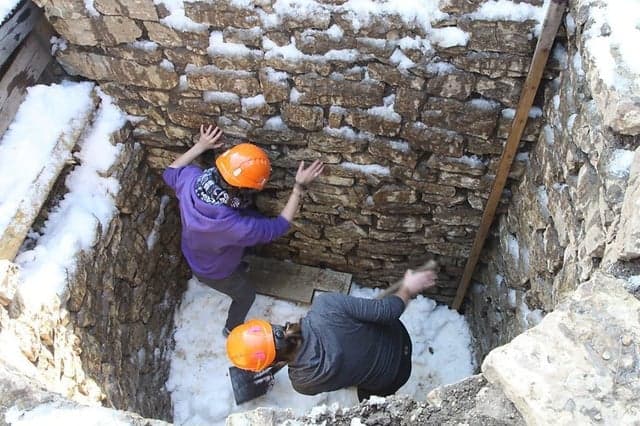Ancient Roman fridge discovered near Basel keeps beer cool for months

Swiss archaeologists studying mysterious shafts unearthed at the Roman site of Augusta Raurica have successfully demonstrated that they can store beer on ice for at least three months, adding weight to their hypothesis that the four-metre pits were designed as ancient refrigerators.
A team led by Professor Peter-Andrew Schwarz at the University of Basel placed a bottle of beer – amongst other things – into one of the shafts in April, packed in compacted snow ice and covered with straw.
As they had hoped, the beer remained chilled when they fished it out on Thursday and took a celebratory swig, the researchers told Swiss news agency SDA.
They believe that Romans used shafts like the examples at Augusta Raurica, located some 20 kilometres from Basel, as cool stores during summer. The shafts were filled with snow and ice during winter and then covered with straw to keep the space cool well into the summer months, allowing everything from cheese to wine – and even oysters – to be preserved during warm weather.
It is the third and most successful time the team has attempted to recreate the Romans' cool box. A first attempt failed after archaeologists filled the shaft with snow all in one go, only to find that the temperature inside remained above freezing point even in winter.
READ ALSO:
-
5,000-year-old dolmen discovered during construction of Swiss garage
-
Archaeologists find 7,000-year-old human remains in Swiss city
-
Time capsule from 1900 discovered in Lausanne wall
The second try had more success: the shaft was filled with snow gradually and blocks of ice were placed inside as well, which kept snow unmelted until June.
For their latest experiment, the team tried a technique borrowed from ice-makers on the Spanish island of Mallorca, who pack densely compacted layers of snow under thick straw for insulation. They also lined the stone shaft with wood and covered the entrance.
The result was that the snow lasted "longer than the sceptics estimated, but not as long as the optimists hoped," Schwarz told SDA.
The next test will be to try storing fruit and vegetables in the shaft. Schwarz said that he and his team would begin a new experiment in August or September in which they see how long fresh produce lasts in the shaft without the help of snow or ice.
While the tests can't prove for certain that Romans used Augusta Raurica's shafts as a fossa nivalis or 'snow fridge', they at least demonstrate that it would have been possible. These latest findings bring us "somewhat closer to the matter," Schwarz said.
Comments
See Also
A team led by Professor Peter-Andrew Schwarz at the University of Basel placed a bottle of beer – amongst other things – into one of the shafts in April, packed in compacted snow ice and covered with straw.
As they had hoped, the beer remained chilled when they fished it out on Thursday and took a celebratory swig, the researchers told Swiss news agency SDA.
They believe that Romans used shafts like the examples at Augusta Raurica, located some 20 kilometres from Basel, as cool stores during summer. The shafts were filled with snow and ice during winter and then covered with straw to keep the space cool well into the summer months, allowing everything from cheese to wine – and even oysters – to be preserved during warm weather.
It is the third and most successful time the team has attempted to recreate the Romans' cool box. A first attempt failed after archaeologists filled the shaft with snow all in one go, only to find that the temperature inside remained above freezing point even in winter.
READ ALSO:
- 5,000-year-old dolmen discovered during construction of Swiss garage
- Archaeologists find 7,000-year-old human remains in Swiss city
- Time capsule from 1900 discovered in Lausanne wall
The second try had more success: the shaft was filled with snow gradually and blocks of ice were placed inside as well, which kept snow unmelted until June.
For their latest experiment, the team tried a technique borrowed from ice-makers on the Spanish island of Mallorca, who pack densely compacted layers of snow under thick straw for insulation. They also lined the stone shaft with wood and covered the entrance.
The result was that the snow lasted "longer than the sceptics estimated, but not as long as the optimists hoped," Schwarz told SDA.
The next test will be to try storing fruit and vegetables in the shaft. Schwarz said that he and his team would begin a new experiment in August or September in which they see how long fresh produce lasts in the shaft without the help of snow or ice.
While the tests can't prove for certain that Romans used Augusta Raurica's shafts as a fossa nivalis or 'snow fridge', they at least demonstrate that it would have been possible. These latest findings bring us "somewhat closer to the matter," Schwarz said.
Join the conversation in our comments section below. Share your own views and experience and if you have a question or suggestion for our journalists then email us at [email protected].
Please keep comments civil, constructive and on topic – and make sure to read our terms of use before getting involved.
Please log in here to leave a comment.